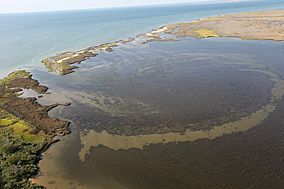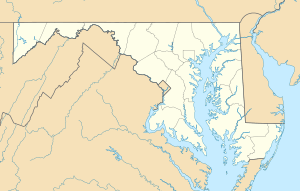Glenn Martin National Wildlife Refuge facts for kids
Quick facts for kids Glenn Martin National Wildlife Refuge |
|
|---|---|
|
IUCN Category IV (Habitat/Species Management Area)
|
|

Cove at Martin National Wildlife Refuge
|
|
| Location | Somerset County, Maryland, Accomack County, Virginia, United States |
| Nearest city | Crisfield, Maryland |
| Area | 4,548 acres (18.41 km2) |
| Established | 1954 |
| Governing body | U.S. Fish and Wildlife Service |
| Website | Glenn Martin National Wildlife Refuge |
The Glenn Martin National Wildlife Refuge is a special protected area for animals. It includes the northern part of Smith Island in Maryland and Watts Island in Virginia. Both of these islands are located in the lower Chesapeake Bay.
This refuge was started in 1954. A man named Glenn L. Martin gave 2,569 acres of land to the U.S. Fish and Wildlife Service. Since then, more land has been added, and the refuge is now 4,548 acres big. This area has tidal marshes, coves, creeks, and high land with plants. It's a very important place for thousands of waterfowl (birds that live near water) to rest and spend the winter. It's also a safe home for many other animals to nest and raise their young.
Contents
About Glenn Martin National Wildlife Refuge
The Glenn Martin National Wildlife Refuge is the largest part of the Chesapeake Islands Refuges. This group also includes Spring Island, Barren Island, and Bishops Head in Maryland. All these refuges are managed by the Chesapeake Marshlands National Wildlife Refuge Complex. This complex is located in Cambridge, Maryland, and it also looks after the Blackwater National Wildlife Refuge and the Susquehanna River National Wildlife Refuge.
Why is this Refuge Important?
The refuge's different habitats, like the tidal marsh, coves, creeks, and ridges, are very important. They provide a safe place for thousands of migratory waterfowl to rest and spend the winter. They also offer nesting areas for many kinds of wildlife throughout the year.
Amazing Animals at the Refuge
Many different animals live in the Glenn Martin National Wildlife Refuge. The types of animals you see can change with the seasons.
Birds that Visit or Live Here
In winter, you might see birds like black ducks, pintails, mergansers, long-tailed ducks, scoters, bufflehead, Canada geese, and tundra swans.
During spring and summer, the marsh grasses, many insects, and underwater plants attract other birds. These include black ducks, mallards, gadwall, and green-winged teal. They come here to nest.
Along the marsh grasses, mudflats, and sand bars, you can find gulls, terns, black skimmers, oystercatchers, and willets. These birds nest and find food in these areas.
The wooded ridges in the refuge are also important. They provide nesting spots for several water birds. For example, ten different types of birds, like herons, egrets, and glossy ibis, have been seen nesting together in groups called rookeries. A rookery is like a bird colony where many birds build their nests close to each other. The Martin National Wildlife Refuge has the biggest group of brown pelicans in the Maryland part of the Chesapeake Bay.
Other Wildlife in the Marsh
Besides birds, a small number of other animals also live in the marsh areas. These include red foxes, muskrats, mink, otters, voles, northern diamondback terrapins (a type of turtle), and different kinds of non-venomous water snakes.
Some special birds that depend on this protected habitat are clapper rails, seaside sparrows, and marsh wrens. Peregrine falcons, which are very fast birds of prey, have been nesting here every year since 1984. That's when the first special nesting tower for them was put up.
The marsh and estuary (where the river meets the sea) are also important for marine animals. Crabs and oysters live here, and they are a key part of the food chain for many other animals.



